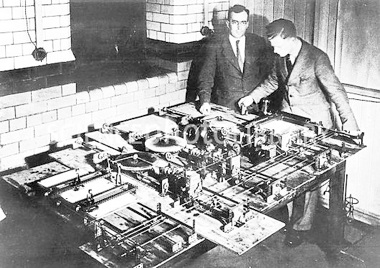Differential Analysers

Others
Marshall University - Prof Bonita Laurence - 2007
Based upon Arthur Porter Machine. See: Detailed write-up.
West Virginia Public Broadcasting article with explanation of benefits to students: Lab304: Math Machine (8m23)
University Of Illinois - Arnold Nordsieck Differential Analyzer -1956
Cursory views of exhibit at Computer Science Museum Silicon Valley by TilTuli: Nordsieck Differential Analyzer -1956 (2m31)
Peter Holtam Differential Analyser - 2009
Silence footage of a very good home-brewed machine: Meccano Diifferential Analyser
Simpson College Differential Analyzer Club 2011
Brief introduction to their Meccano machine at Science Centre Iowa: Differential Analyzer Club presents at Science Center of Iowa
General Electric Differential Analyser
News footage. See The Think Machine Tab UCLA -Samueli.
Since 1977 at the Smithsonian Institute: UCLA's Mechanical Brain: 1948 (2m59)
Computer Animation 2011 - Planimeter
No commentary but animated phrases show the principle of operation: Differential Analyser (2m04)
Life Story of Vannevar Bush
MIT commentary on the career of this amazing inventor who started Ratheon.
It’s worth doing a separate YouTube search on his name as there are a lot of videos about him out there -some good some very poor eg: Vannevar Bush (4m39)
Disclaimer
Whilst some care has been taken to check externally linked websites no responsibility is offered nor implied for the suitability, legality or reliability of content therein.
What Is A Differential Analyser
Everywhere we look there is change and predicting change is fundamental to understanding any environment. Initial understandings of the changes taking place in nature are innate to life’s survival eg seeing night follow day or the return of good weather after a winter season. However man has always sought to go further in his predictions eg to predict the tides of the sea or movement of celestial bodies. However it wasn’t until 1631 when Newton, then Liebnitz and others, formalised the mathematics of so called dynamic systems that more complex problems became more easily solved.
If you are still unfamiliar with the idea take a look at the subpage: What Are Differential Equations
As Babbage had made a machine to perform repetitive mathematical operations in 1822 the desire to make a machine to solve real world natural diffeerential problems became ever more pressing. In 1836 Coriolis made a simple machine to solve first order equations which was quickly developed by the stunning brothers James Thomson and then his younger sibling Lord William Kelvin in 1872.
How To Build A Differential Analyser
An extremely thorough explanation by William Irwin of the Auckland Meccano Guild. Read this before building one: The Differential Analyser Explained
History Of Differential Analysers
Undergraduate student under Douglas Hartree Dr Jack Howlett (CBE in 1993) wrote this well researched potted history of DA’s: Differential Analysers
Vannevar Bush's Differential Analyzer
MIT’s fairly basic introduction to his machine (adly the links to the videos don’t work): Vannevar Bush's Differential Analyzer
Dr Michael Adler’s Fully Meccano Differential Analyser
A very succinct write up of how they work for the International Society Of Meccanomen: Meccano Differential Analyser
Tim Robinson’s Wonderlist
A tremendous anthology of all the technology that Tim thinks important (in alphabetical order of author): Bibliography
Differential Analysers Explained on Websites
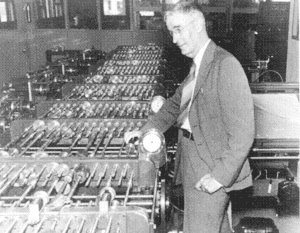
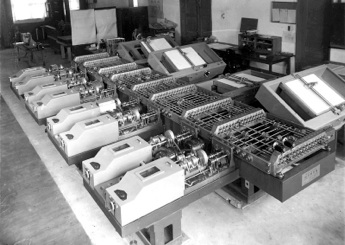
Hartree&Porter with their Meccano DA
(Manchester 1935) Click for better picture.
Vannevar Bush with his giant programmable RDA2 with 18 integration tables (Maryland 1941)
Electronic Torque Amplified DA (Tokyo 1942)
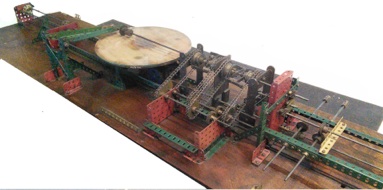
A Differential Analyser is an analogue device for solving equations describing rates of change that are dependent upon more than one variable at the same time.
Equations like these appear in every area of natural change be that in growth, decay or waste; trade, in economics or in population growth; in Engineering such as structures, engines, in use of power generation or flight; in warfare, in space flight or the movement of stars or planets.
A simple integrator as devised by Hartree & Porter
The starting gun had been fired and so many more machines were built to solve more and more complex problems. Speaking of which it must be said that it was the advent of war that finally made the necessity so acute that an accurate working real-time device became literally a matter of life or death. It is the equations of ballistics that some of the machines below were designed to solve.
Differential Analyser Videos On YouTube

Tim Robinson’s Copy Of Hartree’s Differential Analyser
Cursory introduction of Tim Robinson by Neil Fraser:
Close ups of machine running but no explanation by by Tim Robinson at Vintage Computer Festival:
Quick look by GeePeerces at Vintage Computer Festival 2016:
Differential Analyser Origins
Planimeter
Whilst these analysers may seem rather theoretical they all perform very practical tasks. For instance if a farmer wanted to plant seeds evenly over an irregularly shaped field how many seeds would he need ? Of course it would depend on the area. The same might apply if you needed to apply paint to an irregular shape. In 1854 the Swiss mathematician Jacob Amsler-Laffon built the first modern Planimeter which when traced around any irregular shape gave a value to the area inscribed. Very clever. Here we have another numerical output given a graphical input. Wikipedia describes:

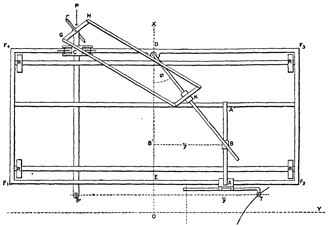
Integraph
In 1836 the French mathematician Gaspard-Gustave de Coriolis first described a device for plotting integrals from a graph. Not surprisingly he called it his Integraph. The input to this was a point, guided by the user, that traced the differential curve to be solved. The output was a counter on a disk that rolled along the paper without slipping. One can see that development of this idea might lead a clever person to the continuously variable motorised device we know and love. The Integraph’s simple first order maths is described here:
Coriolis’ Integraph (1836)
Laffon’s Planimeter (1854)
University of Kent Engineering History Project
Ian Henwood’s copy of Hartree’s HDA at University Of Kent: Detailed Photographs (2018)
PhD Project
In 2018 historian Tom Ritchie discussed and demonstrated the unlikely link between the children’s toy Meccano and the birth of computers (in collaboration with the Science Museum, Kensington). Tom, working with two 'Meccanomen' (Ian Henwood and Matthew Goodman), explores how the rebuilt differential analyser works. This demonstration was designed to appeal beyond simply those who traditionally attend academic lectures, engaging children, young adults, and the general public, avoiding jargon and confusing language as much as possible, to help them engage with challenging historical, mathematical and engineering concepts in a simple, 'hands-on' way. This was organised with the help of the Templeman Library, the Special Collections and Archives Team, the School of History, the Science Museum. For more on this project and other work: Personal Blog: https://tomritchie.co.uk/ Twitter: @Tom_Ritchie1 Email: tawr4@kent.ac.uk _ When asked to think about computers, what is the first thing that comes to your mind – maybe the big ones, like Steve Jobs and the iPhone, Bill Gates and the Microsoft computer, or Alan Turing and Enigma? But very few of us would think of Douglas Hartree and his Differential Analyser. Yet, before the Second World War, in 1934, Hartree and this analogue computer were at the forefront of computing, both in Britain and abroad. In fact, the Hartree Differential Analyser was the first analogue computer of its kind to be built in the U.K. What are analogue computers? Analogue computers rely on the mechanical movement of continuously changing physical quantities to create answers. Whereas digital computers – the laptops and smartphones that shape our world today – resolve equations, using binary language (i.e., in the form of 0 and 1). Put simply, if you could look at analogue computers in action, you would actually be able to see an equation move through them mechanically, from the input table, through the integrating units, to the answers that are drawn by the output table. This was the genius behind Douglas Hartree’s alternative approach to computing. His analyser was only the beginning. It led to the development of a number of other machines, which were used during the Second World War to calculate anti-aircraft ballistics trajectories and the Tube Alloys initiative (Britain’s own nuclear weapons programme). What makes the Hartree Differential Analyser even more impressive is the unlikely material it was built with. Forget diodes and motherboards, Douglas Hartree and his research student Arthur Porter constructed one of the world’s first computers from the children’s toy Meccano.
Working Demonstration
Demonstration and theory of Hartree’s Differential Analyser by Matt Goodman & Ian Henwood:
YouTube: Exploring how the differential analyser works in simple terms (four parts)
Discussion
How the invention of Meccano led to the first practical differential analysers to be developed:
YouTube: Discussion by Tom Ritchie, Matt Goodman & Ian Henwood (six parts)
Explanation Of The Original Meccano Hartree Differential Analyser No 2
William Irwin’s thorough treatise. It has a link to more pictures when the Robinsons visited in 2008: The Differential Analyser Explained
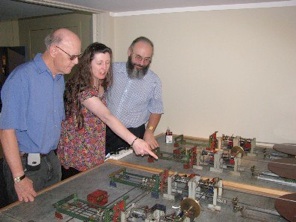
Tim & Lisa Robinson visit the author in 2008
